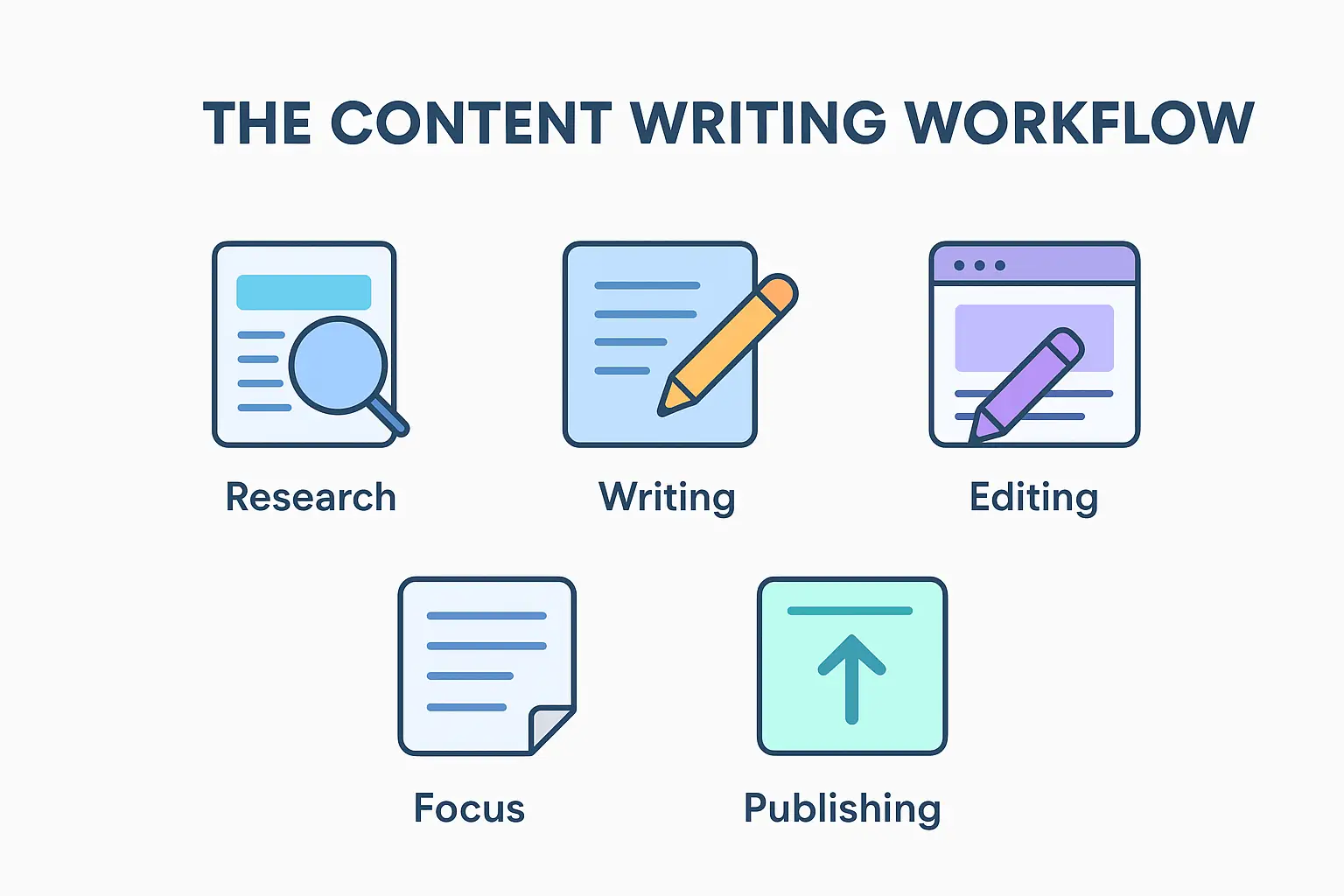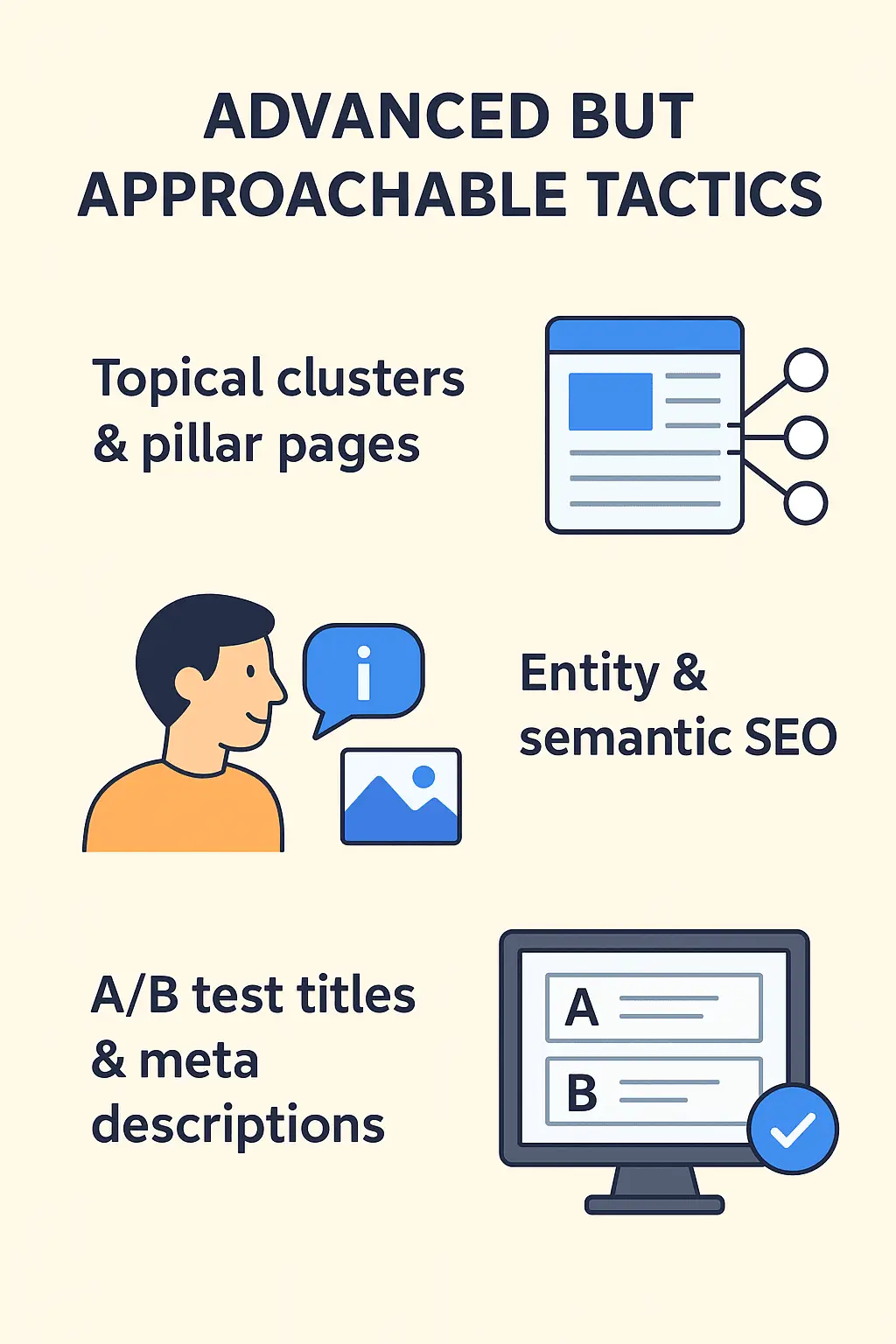Learn the beginner-friendly step-by-step process for writing SEO content that ranks — from keyword research and intent to on-page structure, featured snippet tactics and a printable checklist.
Introduction
If you’re writing blog posts, guides, or landing pages and wondering why they don’t get traffic — this guide is for you. SEO content writing is the craft of creating content that gives people useful answers and tells search engines clearly what your page is about. Done well, it brings consistent organic traffic over time — often the single most cost-effective channel for long-term growth. According to industry data, search still powers a large share of online discovery — making SEO a core skill for any content creator.
In this guide you’ll get a step-by-step process, checklist and simple tactics to target featured snippets and improve click-throughs.
What is SEO content writing?
SEO content writing = writing content for humans that’s intentionally structured and optimized so search engines can understand, surface, and match it to the right queries.
Key idea: write for people first — then scaffold the page so search engines can find and rank it. Google itself emphasizes “people-first” content as the main path to long-term success.
Why SEO content writing still matters
- A large fraction of online experiences still begin with a search engine — search remains a major discovery channel.
- Ranking #1 in Google typically captures a disproportionately large share of clicks compared to positions below it — so small improvements in ranking often lead to big traffic gains. (CTR curves remain steep.)
- Patience is required: industry studies and practitioner data show that meaningful organic gains often take months; some pages that rank at the top are years old, meaning topical authority and updates matter. Expect initial ranking improvements in 3–6 months, while top positions for highly competitive terms can take longer.
- SEO writing pays off over time — but you must plan for quality, topical coverage, and a regular update/promotion process.
The beginner’s 8-step SEO writing workflow

This workflow is the scaffold you’ll follow for every post.
Step 1 — Keyword research (find the right topic)
- Start with a primary keyword phrase (seed) that describes the main idea. Use tools or free sources (Google Autocomplete, People Also Ask, AnswerThePublic) to expand into related queries.
- Pick keywords based on intent — are people looking to buy, learn, compare, or find a quick answer? Match your content to that intent.
Pro tip: Long-tail keywords often convert better and are easier to rank for when you’re starting.
Step 2 — Determine search intent
- Informational (how-to, guides) → write clear, thorough answers and include examples.
- Navigational (brand/website) → optimize title and meta for clicks.
- Transactional (buy/compare) → add product info, benefits, and strong CTAs.
Step 3 — Create an outline (H1 → H2 → H3)
- H1: your primary headline with the main keyword (keep it natural). Example : [Primary keyword + benefit]
- H2s: cover the main subtopics searchers expect. Use People Also Ask and top competitors to see common H2 phrasing. Example : What is [primary keyword]? Why it matters
- H3s: examples, step lists, and FAQ answers.
Step 4 — Write for humans, optimize for search engines
- Use short paragraphs (1–3 sentences).
- Add bulleted lists and numbered steps for scannability.
- Place the primary keyword in the title, first paragraph, at least one H2, and naturally elsewhere. Avoid stuffing. Google prioritizes helpfulness; be useful first.
Step 5 — On-page optimization essentials
- Title tag: include primary keyword and a hook (under ~60 chars).
- Meta description: 120–155 chars; compelling summary with call to action.
- URL slug: short, includes main keyword.
- Headings: clear hierarchy (H1 → H2 → H3).
- Images: descriptive filenames + alt text (see image section below).
- Internal links: link to relevant existing pages — helps crawlability and user flow.
Step 6 — Add structured data (FAQ / Article schema)
- Use JSON-LD for FAQ schema for the short Q&A you include. This helps the page be eligible for rich results (and increases CTR).
- Don’t overdo it — only mark up content that is actually Q&A.
Step 7 — Publish & promote
- Share in your newsletter and social.
- Email people you referenced or who might link.
- Repurpose sections as social posts to drive initial clicks and engagement.
Step 8 — Monitor & update
- Track organic impressions, clicks, and average position.
- Update the page after 6–12 weeks with fresh examples, a new statistic, or improved H2s — older, authoritative pages often outrank newer ones because they are updated.
How long should your SEO content be?
There’s no one-size-fits-all. Instead, match length to intent:
- Short answers / quick how-tos: 600–900 words.
- Standard blog posts / tutorials: 1,200–2,000 words.
- Comprehensive guides / pillar pages: 2,500–5,000+ words.
If the SERP is dominated by long, comprehensive guides, you’ll likely need a longer, more authoritative piece. Conversely, for “quick answer” queries, a short, crisp answers where you can win featured snippets.
Practical rule: analyze the top 3 pages’ lengths for your keyword and target similar or more in-depth content.
Snippet & featured snippet tactics
Featured snippets are prime real estate. Here’s how to target them:
- Put a concise answer (1–3 sentences) directly under an H2 titled with the question. Keep it ≤ 45 words to increase the chances of being used.
- For “list” snippets, use ordered or unordered lists immediately under the H2.
- For “table” snippets, format data into an HTML table.
- Use direct, clear phrasing; avoid fluff.
Beginner-friendly tool – Read SEO Content Writing Tools
On-page checklist
This is a copyable and printable checklist, to optimize the onpage content.
- Primary keyword in title (naturally)
- Primary keyword in first 100 words
- 1–2 secondary keywords included in H2s or H3s
- Short, helpful intro (≤45 words for snippet chance)
- One clear CTA (subscribe, download, contact)
- Meta title & description written and previewed
- Images with alt text and optimized filenames
- Internal link to 2–3 related pages
- External links to authoritative sources (Google, research, industry)
- FAQ block with short answers (for schema)
- Publish date and author bio (E-E-A-T signal)
- Schedule a 6–12 week update check
Common mistakes beginners make and how to fix them
- Keyword stuffing — symptom: unnatural repeating of the target term.
Fix: Use synonyms and entity terms; focus on helpfulness. - Ignoring intent — symptom: writing a long guide for a query that needs a short answer.
Fix: Check People Also Ask / top pages for expected format. - No internal links — symptom: page doesn’t pass link equity or help users navigate.
Fix: Link to related posts and topically relevant pages. - Neglecting promotion — symptom: publish, then wait for traffic.
Fix: Share in channels, ask for links, and repurpose snippets. - No update cadence — symptom: content goes stale while competitors refresh.
Fix: Log updates and set reminders to refresh (6–12 weeks initially).
Using AI responsibly to speed up SEO writing
AI can help with outlines, research notes, and first drafts — but it can also hallucinate and copy. Use this safe workflow:
- Use AI for: draft outlines, idea expansion, meta suggestions, and creating variations of headings.
- Don’t use AI for: final factual claims, data points, or anything you can’t verify.
- Always: fact-check, edit for tone, and add original examples or screenshots.
A Quick example you can follow
A small marketing blog republished a 1,200-word guide and followed these steps: updated the title and H2s to match search intent, added a FAQ block, improved meta description, and promoted the update in an email to 2,000 subscribers.
Result: In 10 weeks, clicks increased by ~40% for the target keyword and the page moved from position 12 to position 6 on Google. (Timing and results will vary — but targeted updates plus promotion often yield measurable gains within a few months). Industry consensus suggests meaningful traffic gains often appear in 3–6 months.
How to measure success (KPIs beginners should track)
- Impressions & clicks (Google Search Console) — are people seeing & clicking your listing?
- Average position — are you moving up over time?
- CTR — improves with better titles & meta descriptions. Use CTR benchmarks for context.
- Organic sessions — users arriving from search who engage with the content.
- Dwell time / bounce rate — proxy for user satisfaction (but interpret with care).
Advanced but approachable tactics to consider for SEO content writing

- Topical clusters & pillar pages — group related posts and use a pillar to build topical authority.
- Entity & semantic SEO — include related entities and people/brand names where relevant.
- A/B test titles/meta descriptions — small wording changes can boost CTR.
- Schema beyond FAQ: HowTo, Article, and Product schemas (if relevant).
Conclusion
Start small. Publish a helpful post that answers a clear question, make it scannable, add a few authoritative external links, and promote it. Track the data and update the content after a couple of months. SEO content writing is a repeating process — the first few posts teach you the patterns; the next set will bring compounding organic gains.
👉 Next Reads:
- AI Content Writing: 5 Proven Steps to Create High-Quality Content
- Content Writing Examples that Boost Engagement and Rankings
- How to Create an SEO Content brief: Step by Step Guide
FAQs
How many keywords should I target per post?
Focus on one primary keyword and 2–4 related secondary keywords and long-tail variants. Keep the page focused and useful.
Can short posts rank?
Yes — for quick answer queries and simple informational queries, concise posts can win. Match the SERP.
How long before I see traffic?
Expect measurable movement in 3–6 months for most posts; some may rank sooner if competition is low.
Do I need paid tools to start?
No — many free tools (Keywordly.ai, Google Keyword Planner, People Also Ask) are enough to start. Paid tools accelerate research.
